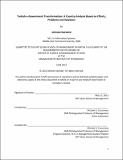| dc.contributor.advisor | Michael A. Cusumano. | en_US |
| dc.contributor.author | İskender, Gökhan | en_US |
| dc.contributor.other | Sloan School of Management. | en_US |
| dc.coverage.spatial | a-tu--- | en_US |
| dc.date.accessioned | 2012-09-11T17:33:00Z | |
| dc.date.available | 2012-09-11T17:33:00Z | |
| dc.date.copyright | 2012 | en_US |
| dc.date.issued | 2012 | en_US |
| dc.identifier.uri | http://hdl.handle.net/1721.1/72650 | |
| dc.description | Thesis (S.M.)--Massachusetts Institute of Technology, Sloan School of Management, 2012. | en_US |
| dc.description | This electronic version was submitted by the student author. The certified thesis is available in the Institute Archives and Special Collections. | en_US |
| dc.description | Cataloged from student-submitted PDF version of thesis. | en_US |
| dc.description | Includes bibliographical references (p. 67-75). | en_US |
| dc.description.abstract | This study analyzes the e-Government transformation in Turkey by presenting a detailed history of efforts between 1990 and 2011. The first chapter of this study presents the focus of the research as an introduction to the subject while the second chapter summarizes the important governmental and institutional developments experienced in the analyzed time frame. The third chapter focuses on evaluating the success of transformation by using data obtained from local sources while the fourth one does the same thing by using data obtained from international benchmark studies. The fifth chapter identifies the problems associated with effectively realizing the e-Government transformation by merging the results of previous analyses with the results of other studies in the literature, and the sixth one proposes solutions to these problems by discussing possible alternatives for each of them considering the problem domain and the current capabilities of the Turkish governmental system. The last chapter before the conclusion presents the developments in two countries which have been applying totally different approaches but successfully realizing an e-Government transformation. The study ends with the conclusion that Turkey should have a well-defined long term strategy and a long term transformation plan developed and implemented by a central authority. However it also emphasizes that all of the other proposed solutions except the existence of a long term strategy and a transformation plan are unique to Turkey similar to those in the countries presented in the previous examples. | en_US |
| dc.description.statementofresponsibility | by Gökhan İskender. | en_US |
| dc.format.extent | 75 p. | en_US |
| dc.language.iso | eng | en_US |
| dc.publisher | Massachusetts Institute of Technology | en_US |
| dc.rights | M.I.T. theses are protected by
copyright. They may be viewed from this source for any purpose, but
reproduction or distribution in any format is prohibited without written
permission. See provided URL for inquiries about permission. | en_US |
| dc.rights.uri | http://dspace.mit.edu/handle/1721.1/7582 | en_US |
| dc.subject | Sloan School of Management. | en_US |
| dc.title | Turkish e-Government transformation : a country analysis based on efforts, problems and solutions | en_US |
| dc.type | Thesis | en_US |
| dc.description.degree | S.M. | en_US |
| dc.contributor.department | Sloan School of Management | |
| dc.identifier.oclc | 808367350 | en_US |
